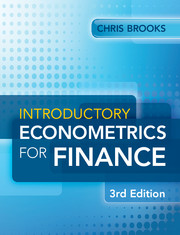Book contents
- Frontmatter
- Contents
- List of figures
- List of tables
- List of boxes
- List of screenshots
- Preface to the third edition
- Acknowledgements
- 1 Introduction
- 2 Mathematical and statistical foundations
- 3 A brief overview of the classical linear regression model
- 4 Further development and analysis of the classical linear regression model
- 5 Classical linear regression model assumptions and diagnostic tests
- 6 Univariate time series modelling and forecasting
- 7 Multivariate models
- 8 Modelling long-run relationships in finance
- 9 Modelling volatility and correlation
- 10 Switching models
- 11 Panel data
- 12 Limited dependent variable models
- 13 Simulation methods
- 14 Conducting empirical research or doing a project or dissertation in finance
- Appendix 1 Sources of data used in this book
- Appendix 2 Tables of statistical distributions
- Glossary
- References
- Index
10 - Switching models
- Frontmatter
- Contents
- List of figures
- List of tables
- List of boxes
- List of screenshots
- Preface to the third edition
- Acknowledgements
- 1 Introduction
- 2 Mathematical and statistical foundations
- 3 A brief overview of the classical linear regression model
- 4 Further development and analysis of the classical linear regression model
- 5 Classical linear regression model assumptions and diagnostic tests
- 6 Univariate time series modelling and forecasting
- 7 Multivariate models
- 8 Modelling long-run relationships in finance
- 9 Modelling volatility and correlation
- 10 Switching models
- 11 Panel data
- 12 Limited dependent variable models
- 13 Simulation methods
- 14 Conducting empirical research or doing a project or dissertation in finance
- Appendix 1 Sources of data used in this book
- Appendix 2 Tables of statistical distributions
- Glossary
- References
- Index
Summary
Learning outcomes
In this chapter, you will learn how to
• Use intercept and slope dummy variables to allow for seasonal behaviour in time series
• Motivate the use of regime switching models in financial econometrics
• Specify and explain the logic behind Markov switching models
• Compare and contrast Markov switching and threshold autoregressive models
• Describe the intuition behind the estimation of regime switching models
Motivations
Many financial and economic time series seem to undergo episodes in which the behaviour of the series changes quite dramatically compared to that exhibited previously. The behaviour of a series could change over time in terms of its mean value, its volatility, or to what extent its current value is related to its previous value. The behaviour may change once and for all, usually known as a ‘structural break’ in a series. Or it may change for a period of time before reverting back to its original behaviour or switching to yet another style of behaviour, and the latter is typically termed a ‘regime shift’ or ‘regime switch’.
10.1.1 What might cause one-off fundamental changes in the properties of a series?
Usually, very substantial changes in the properties of a series are attributed to large-scale events, such as wars, financial panics – e.g. a ‘run on a bank’, significant changes in government policy, such as the introduction of an inflation target, or the removal of exchange controls, or changes in market microstructure – e.g. the ‘Big Bang’, when trading on the London Stock Exchange (LSE) became electronic, or a change in the market trading mechanism, such as the partial move of the LSE from a quote-driven to an order-driven system in 1997.
Information
- Type
- Chapter
- Information
- Introductory Econometrics for Finance , pp. 490 - 525Publisher: Cambridge University PressPrint publication year: 2014
